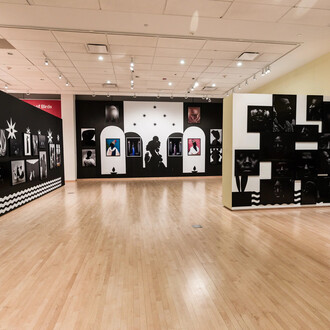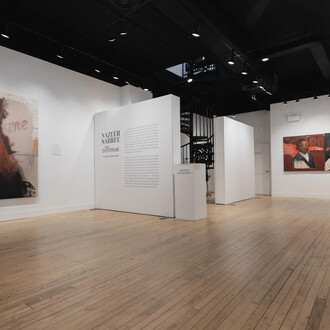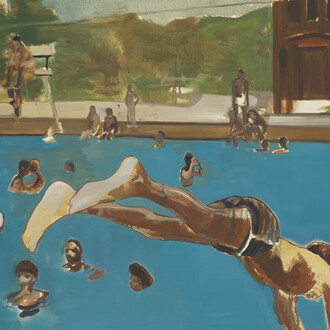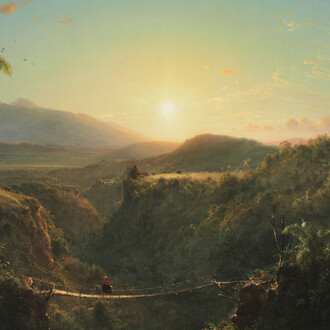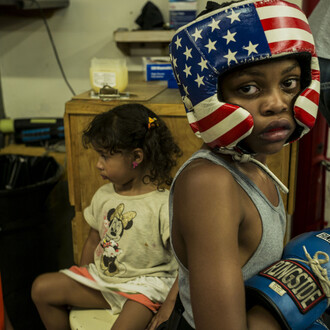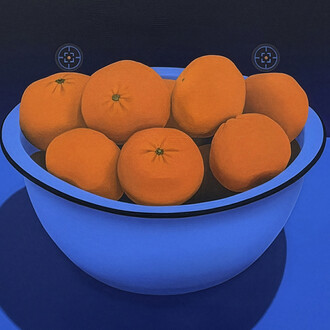Toy stories is an exhibition of sculptural works by Philadelphia-based ceramicist Jeff Rubio. This solo exhibition–Rubio’s first–features all new work; though the artist mined years' worth of sketchbooks to identify common themes, unrealized ideas, and well-trodden personal histories to present a survey of stories that have shaped his identity.
Rubio is best known for his functional objects––a selection of which can be found in the Paradigm gift shop during the show's run––which share the same sense of childlike joy as his fine artworks. The spirit of both his production and studio work perfectly captures the micro-generational experience of being a 90s kid raised primarily on physical media and toys. He repurposes iconography from his childhood as narrative instruments for storytelling.
The transition from producing primarily functional objects to decorative objects began in 2022 with an oversized replica of the beaded lizard keychain, a classic Y2K summer camp craft. This beaded lizard was created in the same colorway as an actual keychain he made at summer camp. Through the use of large-scale ceramic beads cast from molds fashioned by the artist, Rubio manages not to simply reminisce but to recapture what it feels like to be a child; sitting on the ground, assembling the sculptures with giant beads and ropes, he feels like a kid again.
The three oversized Beaded Lizard sculptures from Rubio’s Camp craft series featured in this exhibition also reflect the outsized space these objects take up in our memory, as reflected in the many stories and original camp keychains shown to the artist by viewers who hold the same reverence for the object.
One of the featured works, Don’t wake daddy, is a play on the 90s board game of the same name. This piece features a large watch face and band constructed from ceramic tiles inlaid into faux fur, with the face designed to resemble a Wario-like character: rotund and maniacal. Don’t wake daddy narrates a significant childhood memory where the artist’s father prioritized a shower over calling 9-1-1 during a near-death allergic reaction. This event profoundly influenced Rubio’s recollection of his father, but upon recently revisiting an old voicemail, the artist was struck by the gentleness and soft-spokenness of his father’s voice, which contrasted his long-held perception. By blending elements of humor and serious reflection, the artwork illustrates the intricate and multifaceted nature of personal history and memory. It underscores how our minds extol or vilify people posthumously, influenced by the stories we tell and the memories we choose to emphasize.
From the curator: “The amplified, cartoonish elements in Rubio’s sculptures reflect the big colors and shapes of children’s media, but also the ways our memories distort facts. The imagery may be based on figures from his youth, but Rubio isn’t indulging in nostalgia for nostalgia’s sake. He is rewriting core memories through the lens of compassion and with a sense of humor hard earned through age and experience. Our family members are the most dominant cast of characters in our formative years. It’s easy to believe the stories we’ve always told ourselves about them and it takes intention to break from those assumed roles as our dependence on those who raised us wanes. A sense of discovery through play is very present in this exhibition”.
From the artist: “In developing my initial sketches, I aimed to capture the dynamic essence of the ‘Andy's Coming’ social media trend from Toy story. This trend, characterized by participants abruptly freezing their actions in response to the cue "Andy's coming", inspired me to design pieces that would similarly ‘freeze’ mid-narrative upon the viewer's encounter. The intent was to evoke a moment of suspended animation and provoke curiosity,” says Rubio. “I want viewers to think: What’s going on in Jeff’s mind as we view all these frozen elements from his toybox?”.
Not all of the featured works deal with distant memory. Through works like Shark! Rubio celebrates the present. These works narrate the evolution of his personal preferences and art practice and the vibrant community of artist friends he keeps. The modular nature of so many of Rubio’s sculptures (Pretty Pickle, for example, with its Mr. Potato Head-style removable facial features) center playfulness, an homage to the artist’s close friends who share in this spirit, whether through play with clay, food, or video games.
Jeff Rubio is a Filipino-American ceramicist based in Philadelphia. His practice employs playful motifs yet is highly technical, and rooted in queerness, nostalgia, and joy. Rubio received his BID in Industrial Design from Pratt Institute in New York. He has been featured in group exhibitions at Huddle, Philadelphia and Good Mother Gallery, Los Angeles.
Anaïs Cooper-Hackman is a curator based in Philadelphia, PA. She is the former Associate Director of the now defunct HOT•BED Gallery, an art gallery, event venue, and artist studios in Philadelphia. Among many things, during her time at Hot•bed she helped launch a concept called Micro•gallery, a no-limits playground for guest curators and artists to produce and exhibit unconventional work. The inaugural season of Micro•gallery included a Venice Biennale of Architecture-bound installation by Jefferson University’s Synesthetic Research and Design Lab, a community media lab for the production of experimental art in partnership with Lino Kino, and an immersive neon cave installation by neon bender Alissa Eberle. Currently, she is the Programming & Partnerships Director at Ray, a multi-family real estate company with locations in Philadelphia, PA; Harlem, NY; and Phoenix, AZ where she manages an in-house gallery concept called Studio 105.





